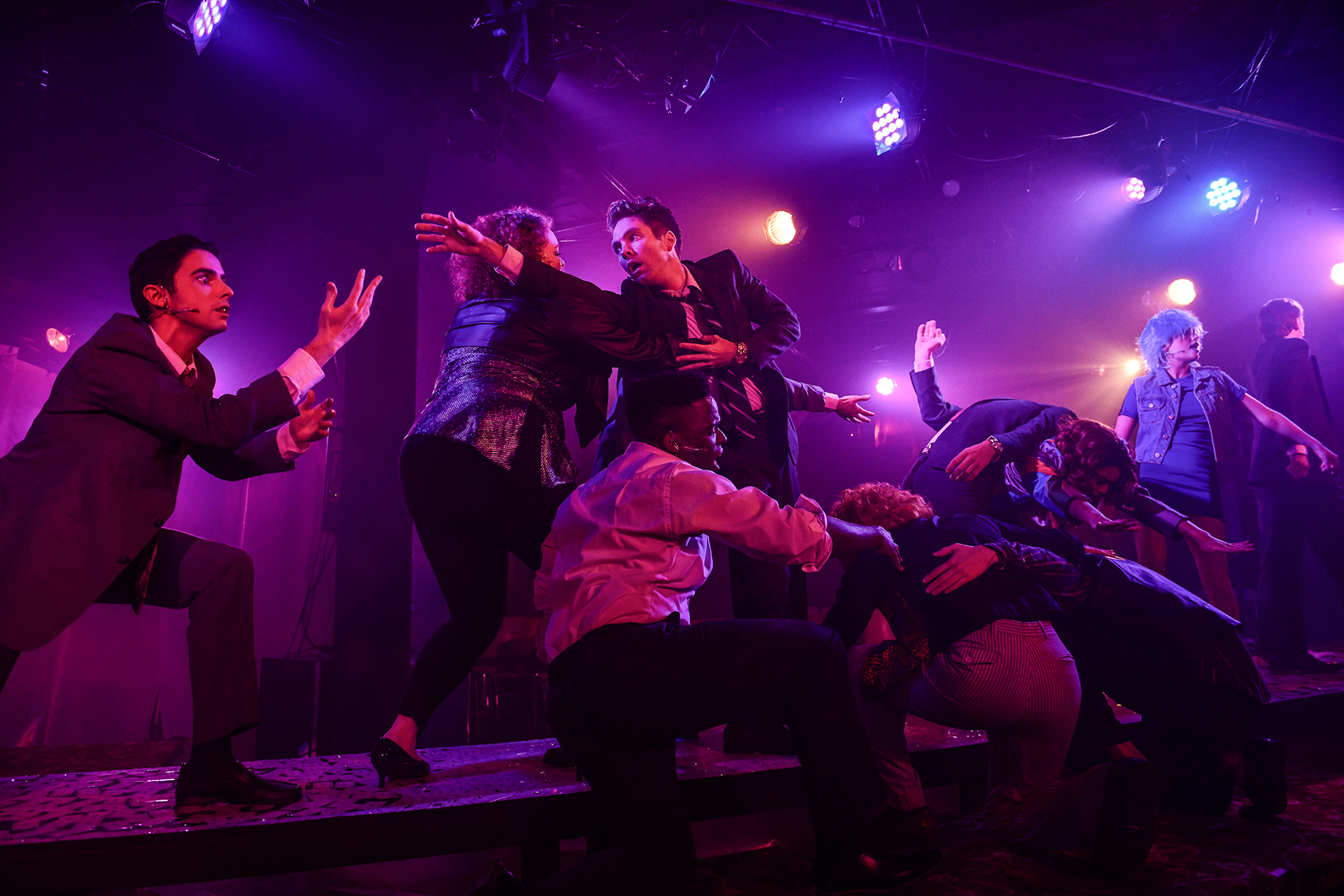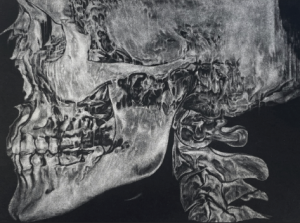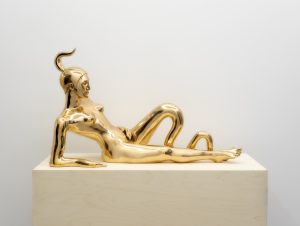Watching Kokandy Productions’ staging of “American Psycho: The Musical” at Chopin Theatre recently got me thinking about the creativity needed to stage what many might say is unstageable. What follows is a consideration of American Psycho’s cultural history and how this history informs Kokandy’s take on the musical’s Chicago premiere.
To talk about the story of American Psycho tends to become an exercise in talking about what one assumes about American Psycho and the emotions such assumptions inspire. In the most clinical terms, it is the story of Patrick Bateman, a psychotic and potentially delusional investment banker, working and murdering in Manhattan during the late 1980s. Bateman, first written in Brett Easton Ellis’ 1991 novel of the same name and adapted to film in Mary Harmon’s 2000 cult classic, bothers audiences. Bateman is an amalgamation of society’s worst ills (he’s a murderer, rapist, racist, homophobic banker who hates everyone) in a perfectly coiffed, Armani-scented package. Under his designer suit is a jacked skin suit and under that, there only exists a void: dark, deep, and ever-present. He fashions himself as an apex predator, rich beyond consequence and untouchable by the law. Nothing pierces him in this world, though he often pierces the worlds of others. When Patrick Bateman is around, no one is welcome. He is a reminder that the world has been built by a shared inhumanity, a land in which empathy is a liability.
This is where the problem commonly occurs. Depictions of Bateman’s violences are often read and analyzed as endorsements of the character’s… well, character. Ellis’ book was originally sold in plastic wrap, picketed, and panned for its graphic violence, while Harmon’s film was also picketed and panned for its graphic violence. Though I am no big fan of Ellis’ writing, (he’s often too bored, too flat, too numbed, sanitized, and complicit within the very culture he desires to critique for my taste) reading American Psycho still feels like worms emerging from your skin. The disgust is visceral, as it should be when reading about dismemberment and disembowelment. A similar feeling occurs when watching Harmon’s 2000 film adaptation: something is wrong with Christian Bale’s Patrick Bateman. You feel like screaming at the screen when another character is taken in by the trappings of his wealth or hours at the gym. It’s a movie that makes you feel queasy after each watch, because it is a world we can recognize. This uneasiness is something that Harmon and her writing partner Genevieve Turner (also one of the creators of HBO’s The “L” Word) hoped to capture as they explicitly wanted the film to function as a critique of heterosexual male vanity.
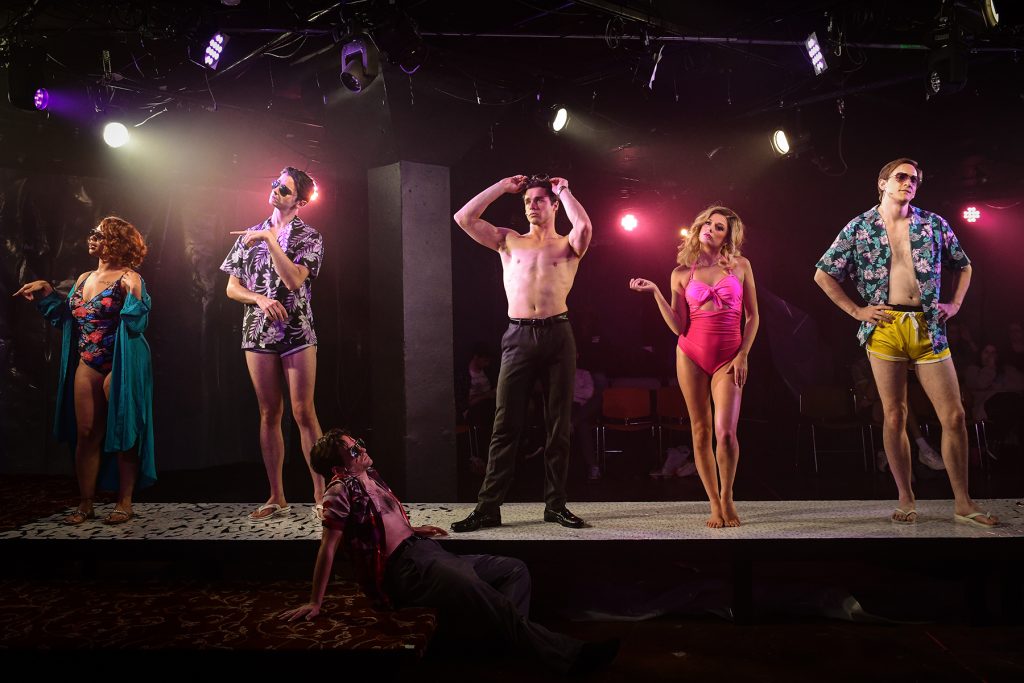
When it comes to art and its potential to tell us something about our world, I believe in the collective duty of artists to tell the truth however uncomfortable it may be. Readings of Patrick Bateman that prioritize safety and censorship diminish our ability to think about what his void could tell us about turn of the century America, a world we still find ourselves in today. A crime can’t be solved if spilled blood is immediately cleaned and our hands insistently washed in silence. Yet, because we live in a moment where debate continues about how to read and understand violent art, both the film and the book tend to live as cultural artifacts of America’s late twentieth century barbarity and vapidity, and litmus tests for how we talk about our own cultural moment.
In 2010, American Psycho: The Musical was borne from this creative lineage. In a partnership between composer Duncan Sheik and playwright Roberto Aguirre-Sacasa, the story of Patrick Bateman was reimagined for the stage. With Sheik writing the songs and Aguirre-Sacasa writing the playbook, the duo began readings with actors in Manhattan while raising money for the project through GoFundMe. The musical premiered in London during 2013. While Sheik has long been a mainstay in New York theater with work on Shakespeare stagings and other Broadway classics (such as Splendor in the Grass), Aguirre-Sacasa’s work in theater and television embraced either mass-produced camp or the gloriously weird. Luckily for us, Aguirre-Sacasa’s work on American Psycho: The Musical fits into the second category.
At the Chopin Theater, Kokandy Productions staged the Chicago premiere of the musical with Kyle Alexander playing the titular role and Sonia Goldberg as Jean, his tender-hearted and vulnerable secretary. With Caleigh Pan-Kita as a very funny Evelyn Williams, Bateman’s increasingly unhinged socialite girlfriend, John Drea as Bateman’s business card-wielding, reservation-having nemesis, Paul Owen, and Danielle Smith and Quinn Kelch as Courtney Lawrence and Luis Carruthers, the cast brings new life to American Psycho’s characters. There is a pervasive sense of perverse fun that director Derek Van Barham brings (a Windy City Times’ 30 under 30 awardee) in collaboration with Breon Arzell (a multiple Joseph Jefferson award winner and a major voice within the Fly Honeys creative leadership) choreography, and Heidi Joosten’s (the Associate Director of Music at Second City’s Main Stage) musical direction. Their shared leadership allows for the source material’s hollowness, the terrifying void that exists in Bateman’s very center, to be laughed at, feared, and perhaps understood.
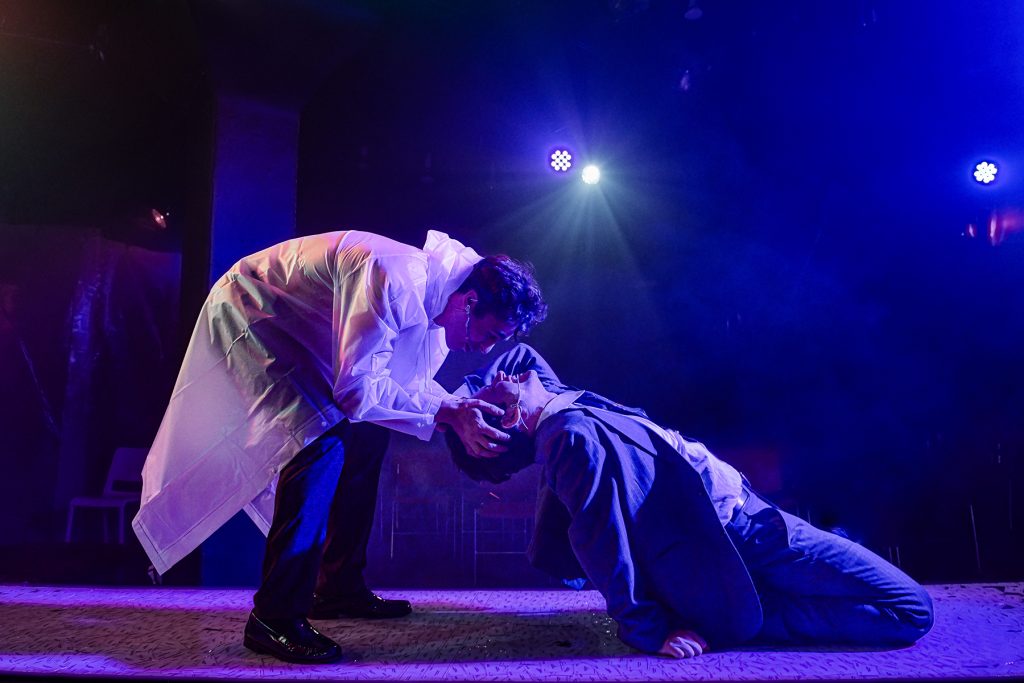
When you enter the Chopin’s basement theater, and move aside layers of curtains made of PVC plastic, an innumerable number of business cards pepper the stage floor. The cards loop upward on each of the theater’s structural support beams. There is a tension between the uniform edges of each card and the chaos of their placement upon the stage, almost no blank space is visible. Strung throughout the elevated stage and the audience there are pieces of obtuse PVC plastic repurposed as screens. On the screens throughout the theater an amalgamation of footage from eighties and early nineties horror films and commercials play. There are masked killers—Jason Vorhees, Michael Meyers, Leatherface—Stephen King movies, commercials for Pepsi, Cream of Wheat, and scenes of undistinguishable urban spaces, money, and Ronald Reagan.
The hybridity of the stage design, the artfully controlled chaos, is fitting for a musical that opens with our main character clad in only white briefs, surrounded by dancers dressed as businessmen. He psychotically describes his grooming regimen, his body, and his increasing alienation from the world around him. Set in the late eighties, Alexander’s Bateman is twenty-six years old during the tail end of the Reagan Administration. It is fitting for Reagan’s disastrous social policies (like the War On Drugs, Reaganomics, and the gutting of social services like food aid and student loan support) to coincide with Bateman’s violent unraveling. The relationship between character and setting shows the era’s descent into economic Darwinism on the level of the collective and the individual. Ask yourself: is murder really too far off from policies that sentence most of the country, especially America’s poor and working class, to death by starvation, loneliness, addiction, displacement, despair? Violence, especially when perpetrated by those with power, echoes and expands. It is an environment that is eerily familiar as we are currently living in its shadows.
The sheer viciousness of Bateman’s Manhattan is punctured by the snappy dialogue that uncovers the character’s childlike vanity. When his nemesis Paul Owen mistakes him for another of their coworkers, Bateman scoffs,
“I have a slightly better haircut”
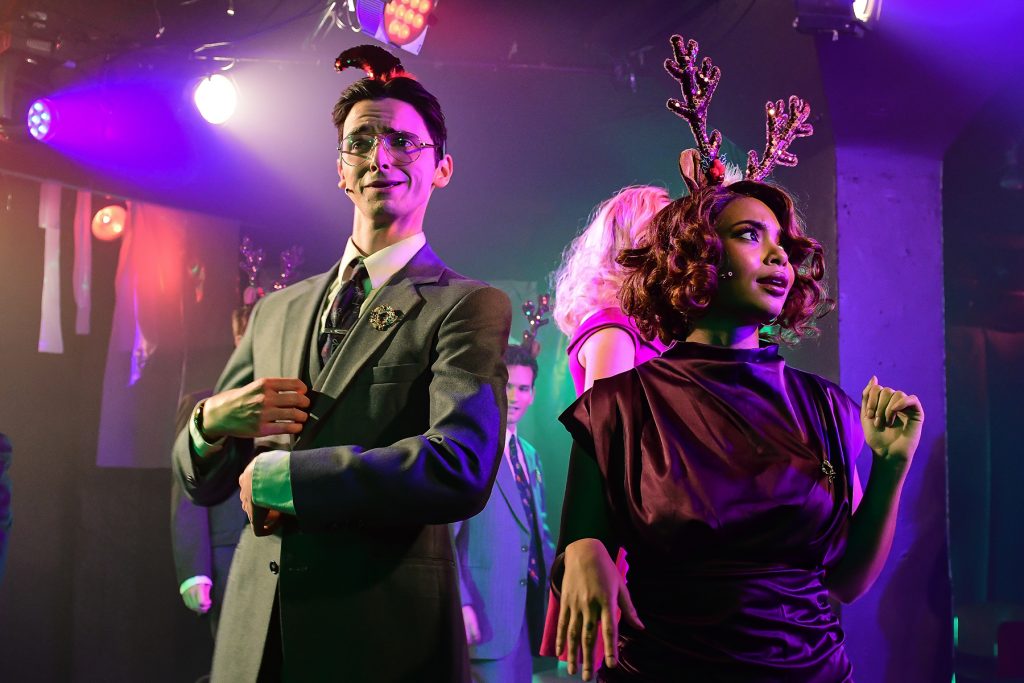
Alexander does a phenomenal job at playing Bateman’s frustration with frivolities like a dry cleaner bleaching his shirts or not getting a restaurant reservation, while simultaneously reminding audiences that he is also a threat to everyone’s wellbeing. However, there is an interesting tension between Bateman’s penchant for violence and his seemingly genuine desire for not only what is expensive, but what is also popular. In an early scene where Pan-Kita’s Evelyn insists on throwing a dinner party for her and Patrick’s “friends”, he uses it as an opportunity to lure Paul Owen into his proximity. During the dinner party, the conversation turns toward New York’s urban renewal. While Owen speaks with sadness about the disappearance of beloved public spaces, Bateman scoffs and rants about the state of the world. Patrick espouses viewpoints from across the ideological spectrum (I caught “a woman’s right to choose”, “removing troops from Central America”, alongside support for the War on Drugs). There is no coherent whole, no point of reference where viewers can find Bateman and this floating subjecthood is the very point of the character, as Alexander sadly sings in the musical’s second act it is hard for him “to make sense on any level, [. . .] I’m a fabrication.” Patrick is not connected to others; he is alone, he is nothing, and he belongs nowhere.
I credit this complication to both Alexander’s delivery and the direction of Arzell and Barham; with crumpled shoulders and a lost, desperate tone, audiences see something horrifyingly wrong with the man that stands before them. Though there are moments of hopeful connection throughout the play, these do not unfold as opportunities for Bateman’s salvation. Rather, the audience sees Bateman reflect those around him, masking his emptiness rather than working to develop it into something substantive, something real, something human. In a conversation with Jean, who remains hopelessly lonely and enamored by Bateman’s impenetrability, the pair find common ground over the new musical, Les Misérables. Jean gushes about Fantine’s infamous solo detailing her mistreatment at the hands of men who she has crossed paths with throughout the years. Patrick excitedly agrees with Jean’s assessment on the song’s beauty. Alexander and Goldberg’s skill complicate the exchange, while the undertow of violence remains ever-present; they’re also blindly, imperfectly, and superficially relating to one another. Jean takes Patrick’s agreement as revelation of his hidden depth, proof that underneath the suits and the muscles there is someone sensitive and kind.
Jean’s view of Patrick, in keeping with Goldberg’s angelic voice, fits within a long line of Gothic heroines: virtuous women who meet untimely ends at the hands of empty men. It is a legacy that feels apt within the confines of moneyed Manhattan as this is a place where anyone empathetic, soft, naïve, or kind does not last long. Though such violences are meted out in seeming equal measure against everyone vulnerable in Bateman’s world (a displaced man, sex workers, an LGBTQIA+ person), they take on a different resonance when his victims are women as Bateman defines himself as a killer of women. Bateman fantasizes about killing girls and luxuriates in their death. In contrast, Bateman describes the murders of those he deems Other or, like the elderly displaced person those who offend his aesthetic sensibilities, as chores akin to returning some video tapes. Both the book and the film’s depictions of violence against women were also major catalysts in the picketing and protests mentioned above. There’s something to this cultural fixation on dead women, as gendered violence is a favored move in the capitalist playbook; it is an easy way to divide and conquer large swathes of people and simultaneously can weaken resistance to interwoven oppressions. While Bateman’s violence against women cannot be ignored, let’s remember that the story of Patrick Bateman is at its heart a story of violence against everyone.
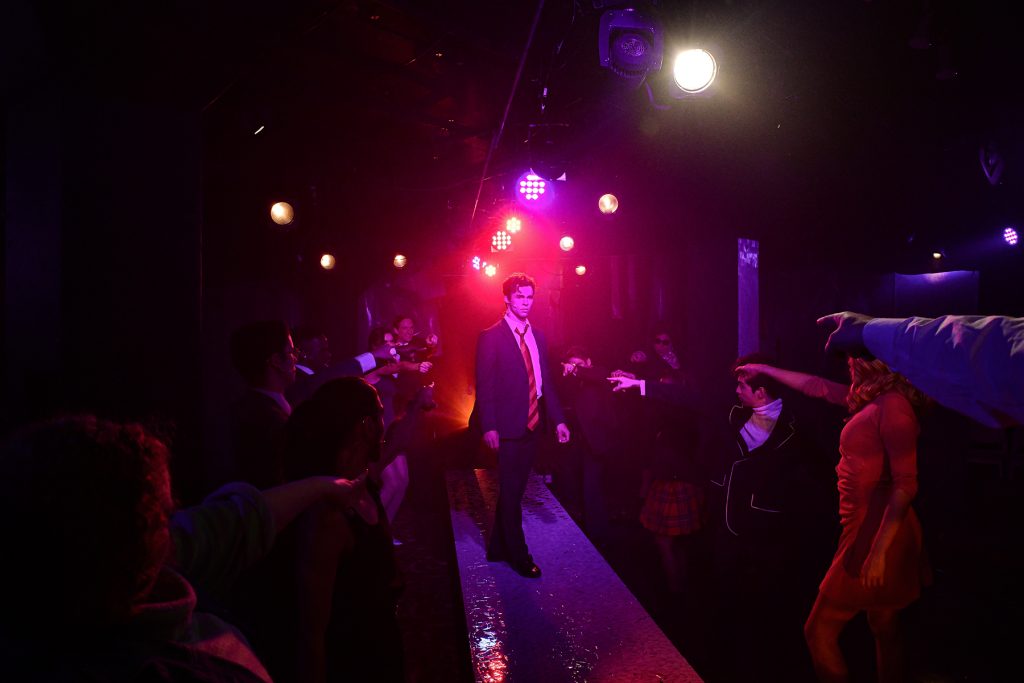
In Harmon’s film there is an infamous scene where Patrick Bateman hires two sex workers, Christie and Sabrina. He brings both women home to his apartment where he engages in violent sex and both women immediately check out and spend most of their scene lying passive, like dolls. He flexes his biceps in the mirror for his own pleasure and they pray with their eyes for the job to end. I hesitate to even call it sex, as it mostly functions as a physical exercise of Bateman’s ego. It is not about desire in its myriad forms (which can sometimes be welcomingly violent), but how narcissism is fruitless, empty, and always comes at the expense of others. How do you stage a scene like this for the theater?
The musical’s adaptation of these scenes shows intimacy designer Kirsten Baity and Arzell’s genius at their most dazzling. Bateman grows increasingly unstable and violent. He recounts to the audience the various injuries he inflicts on sex workers, Christine (Quinn Simmons) and Sabrina (Emily Holland). During their sessions, Holland and Simmons flank Alexander on the left and right, while he, dressed in only white briefs, lifts his arms in an abstracted mimic of a puppeteer, wildly jerking and bending the other two into painful arches. While some of the choreography is reminiscent of various sexual positions, Holland and Simmons’ spot on ability to mirror one another as they grimace through increasingly intense contortions, makes one think more of the body’s propensity to wound and break under duress.
While the source material did not mention diverse gender expression, Simmons’ identity as a gender non-conforming person asks audiences to confront the pervasiveness of the violence Bateman represents. Bateman is the embodiment of racial capitalism and patriarchal violences. Simmons’ presence on the stage—beyond their talent as a performer—serves as an important reminder that many members of the queer community face down these violences day after day after day. Such a reminder is also especially prescient for the exploration of sex work in Bateman’s world. For Bateman, once money exchanges hands, Christine and Sabrina are his to do with as he wishes. Their boundaries and safety be damned. Bateman wants to hurt Sabrina and Christina. Everyone othered in Bateman’s world are means to his ends; everyone is vulnerable to the death that lives in his hands.
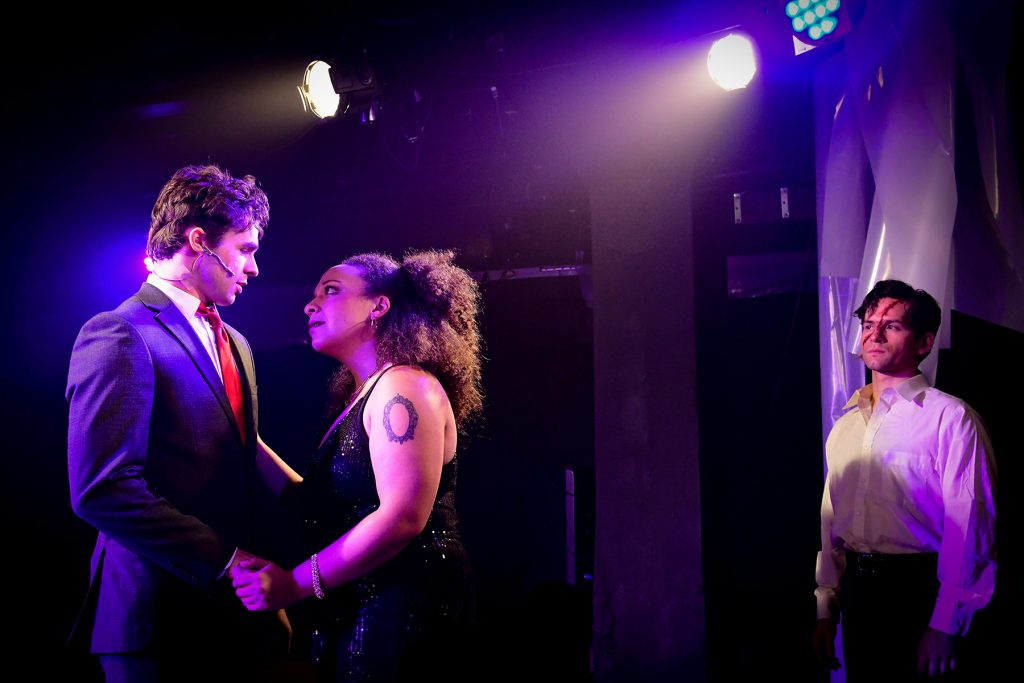
Whether this new facet of queerness within the “American Psycho” canon gives welcome exposure to the breadth of Bateman’s violences or if that same violence is an identical recursion into the void, remains unknown. Capitalism has a penchant for accelerating, expanding, and consuming its own opposition. Yet, ask yourself this: is it worse to die by grotesque violence or to die by never having existed at all? It is an impossible question to answer, but this nowhere cannot be our only option.
This idea of breakage, of the body and the heart’s vulnerability against capitalism’s many violences, lies at the center of this American Psycho. Near the play’s end, Alexander joins the cast, one face in a line of many faces, to say that his name is Patrick Bateman, he is 27 years old, and he lives in New York City at the end of the century. His face breaks, his voice breaks, everything he knew about his life before those moments, breaks. Not even Patrick Bateman can face the ramifications of what it means to be Patrick Bateman; to sharpen his teeth and knives in the world that he built. There is a lesson here too, to not shy away from the emptiness Bateman represents but to understand it leads to nowhere. Nowhere cannot be our only option.
“American Psycho: The Musical” plays through Sunday, December 10 at the Chopin Theatre. You can purchase tickets and find out more information here.

About the Author: Annette LePique’s writing has appeared in ArtReview, Chicago Artist Writers, Chicago Reader, Eaten Magazine, New Art Examiner, NewCity, Ruckus Journal, and many other publications. She received master’s degrees from the School of the Art Institute of Chicago and the University of Chicago, and is a 2023 recipient of the Rabkin Prize for art journalism.
